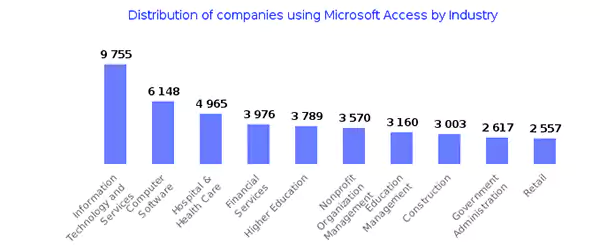KEY TAKEAWAYS
- Utilizing the features of Microsoft Access for project management, customer databases, and inventory will streamline your work efficiently.
- Employing input masks and data validation rules guards against incorrect data entry preserving the integrity of the records.
- Automate your data with Macros and VBA by customizing processes which will save significant time.
- Keep your database updated to avoid accidental deletion and data corruption.
With its many features and capabilities, Microsoft Access is a robust database management solution that can assist you in efficiently organizing and analyzing your files. There’s always room for improvement regarding efficiency and streamlining activities, regardless of expertise level.
In this blog, we’ll explore some useful Microsoft Access Functions and productivity-boosting advice. Consider enrolling in an Access Course to expand your knowledge and abilities to become an expert with this vital instrument.
Use Templates Wisely
Using the pre-made templates in Microsoft Access is one of the fastest methods to get started. It offers numerous templates for various uses, including customer databases, project management, and inventory tracking.
You can save time and work using these templates, including pre-designed forms and structures. But feel free to alter them to meet your requirements.
Create Relationships
Multiple tables containing related information must frequently be handled for effective database management. Creating associations between tables helps simplify complex queries and preserve data integrity. Learn how to define and easily manage these connections using Access’s Relationships feature.
Master Query Design
Every online record system’s core component is its query. To optimize productivity, master the Query Design view.
This allows you to design customized queries and extract the required information precisely. Use SQL statements, criteria, and expressions to fine-tune your queries for the best outcomes.
Use Indexing
Your database’s performance can be greatly enhanced by indexing your tables. Indexes are relevant when working with huge datasets as they hasten file retrieval. Avoid over-indexing, though, as this can obstruct the insertion and update.
DO YOU KNOW
Microsoft Access has two built-in utilities, Database Splitter, and Linked Table Manager, to facilitate this architecture.
Implement Data Validation
In online record administration, integrity is relevant. You can ensure your information is reliable and consistent by employing input masks and data validation rules. These functions guard against incorrect data entry and preserve the integrity of your records.
Automate Tasks with Macros
With Access, you can use macros to automate repetitive activities. Through the ability to record a sequence of operations and replay them with a single click, macros can streamline complicated tasks, including file imports. You can save significant time by using this in your regular workflow.
Leverage VBA (Visual Basic for Applications)
Explore VBA for more complex automation and customization. You can design unique processes and routines with this programming language to meet your requirements. Expanding Access’s functionality and automating complex procedures using VBA is possible.
It is because of its unique features and robust database capabilities that Microsoft Access is used by industries.

Regularly Compact and Repair Databases
Over time, huge databases can cause a decline in performance. To maximize performance, make it a habit to repair and condense your records frequently. This will guard against corruption and preserve data integrity.
Backup Your Database Regularly
Loss of files can be disastrous. Remember to back up your records in a safe place regularly. By offering backup copy creation, Microsoft Access enables you to restore data in case of accidental deletions or database corruption.
Stay Informed and Seek Training
Microsoft Access is no exception to the rule that technology is always changing. Visit online forums, official documents, and online resources to stay updated on upgrades and new features.
Enrolling in its course, which offers structured learning and practical experience with the newest capabilities and techniques, will help you get a deeper understanding and competency.
Utilise Access as a Front-End for Other Databases
Excel, SQL Server, SharePoint, and other information sources can all have a front-end interface provided by Microsoft Access. This keeps the files in a more reliable backend system while allowing you to use its intuitive interface. To improve your productivity, become knowledgeable about connecting to and interacting with external data sources.
Customise Forms and Reports
Adapt your reports and forms to your unique data entry and reporting requirements. Access offers a variety of design options to assist you in producing reports and forms that appear professional and efficiently present information.
Conclusion
You can manage and analyze files using Microsoft Access in various ways, and these hints and tips will help you get the most out of using it. Even if you are using it for work-related or personal tasks, it’s necessary to keep learning new skills and remaining current with its functions.
Consider signing up for an Access course to learn more about advanced subjects and improve your database management abilities. You can become an expert in using it and improve productivity by optimizing your data-related duties and workflow with practice and commitment.